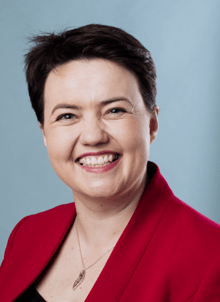Next Scottish Parliament election
|
| |||||||||||||||||||||||||||||||||||||||||||||||||||||||||||||
| |||||||||||||||||||||||||||||||||||||||||||||||||||||||||||||
All 129 seats to the Scottish Parliament 65 seats needed for a majority | |||||||||||||||||||||||||||||||||||||||||||||||||||||||||||||
|---|---|---|---|---|---|---|---|---|---|---|---|---|---|---|---|---|---|---|---|---|---|---|---|---|---|---|---|---|---|---|---|---|---|---|---|---|---|---|---|---|---|---|---|---|---|---|---|---|---|---|---|---|---|---|---|---|---|---|---|---|---|
| Opinion polls | |||||||||||||||||||||||||||||||||||||||||||||||||||||||||||||
| |||||||||||||||||||||||||||||||||||||||||||||||||||||||||||||
| |||||||||||||||||||||||||||||||||||||||||||||||||||||||||||||
The next Scottish Parliament election is due to be held on 6 May, 2021[1] to elect 129 members to the Scottish Parliament. It would be the sixth election since the devolved parliament was established in 1999.
Five parties had MSPs in the fifth parliament: Scottish National Party (SNP) led by First Minister Nicola Sturgeon, Scottish Conservatives led by Ruth Davidson, Scottish Labour Party led by Richard Leonard, Scottish Greens, led by their co-conveners Patrick Harvie and Maggie Chapman, and the Scottish Liberal Democrats, led by Willie Rennie.
Date
Under the Scotland Act 1998, an ordinary general election to the Scottish Parliament would normally have been held on the first Thursday in May four years after the 2016 election, i.e. in May 2020.[2] This would have clash with the proposed date of the 2020 United Kingdom general election but became a moot point when the latter was brought forward to 2017.[3] In November 2015, the Scottish Government published a Scottish Elections (Dates) Bill, which proposed to extend the term of the Parliament to five years.[3] That Bill was passed by the Scottish Parliament on 25 February 2016 and received Royal Assent on 30 March 2016, setting the new date for the election as 6 May 2021.[1]
The date of the poll may be varied by up to one month either way by the monarch, on the proposal of the Presiding Officer.[2]
If Parliament itself resolves that it should be dissolved, with at least two-thirds of the Members (i.e. 86 Members) voting in favour, the Presiding Officer proposes a date for an extraordinary general election and the Parliament is dissolved by the monarch by royal proclamation.[4]
It does not necessarily require a two-thirds majority to precipitate an extraordinary general election, because under the Scotland Act Parliament is also dissolved if it fails to nominate one of its members to be First Minister within certain time limits, irrespective of whether at the beginning or in the middle of a parliamentary term.[4] Therefore, if the First Minister resigned, Parliament would then have 28 days to elect a successor (s46(2)b and s46(3)a). If no new First Minister was elected then the Presiding Officer would ask for Parliament to be dissolved under s3(1)a. This process could also be triggered if the First Minister lost a vote of confidence by a simple majority (i.e. more than 50%), as s/he must then resign (Scotland Act 1998 s45(2)). To date the Parliament has never held a confidence vote on a First Minister.
No extraordinary general elections have been held to date. Any extraordinary general elections would be in addition to ordinary general elections, unless held less than six months before the due date of an ordinary general election, in which case they supplant it.[4] The subsequent ordinary general election reverts to the first Thursday in May, a multiple of five years after 2011.[4]
Election system, seats, and regions
The total number of Members of the Scottish Parliament (MSPs) elected to the Parliament is 129.
The Scottish Parliament uses an Additional Members System, designed to produce approximate proportional representation for each region. There are 8 regions, each sub-divided into smaller constituencies. There are a total of 73 constituencies. Each constituency elects one MSP by the plurality (first past the post) system of election. Each region elects 7 additional MSPs using an additional member system. A modified D'Hondt method, using the constituency results, is used to elect these additional MSPs.[5][6]
The boundaries of the 73 constituencies last changed as of the 2011 Scottish Parliament election, as did the configuration of the electoral regions used to elect "list" members of the Scottish Parliament,[7]. These revisions were the outcome of the First Periodical Review of the Scottish Parliament's constituencies and regions conducted by the Boundary Commission for Scotland; the Review was announced on 3 July 2007 and the Commission published its final report on 26 May 2010.
The Scottish Parliament constituencies have not been coterminous with Scottish Westminster constituencies since the 2005 general election, when the 72 former UK Parliament constituencies were replaced with a new set of 59, generally larger, constituencies (see Scottish Parliament (Constituencies) Act 2004). The size difference between Westminster and Holyrood boundaries is due to diverge further upon the implementation of the Sixth Periodic Review of Westminster constituencies, which will further reduce the number of Scottish Westminster constituencies to 53.
Opinion polling
Various organisations carry out opinion polling to gauge voting intention ahead of the election.
Target seats
Below are listed all the constituencies which require a swing of less than 5% from the 2016 results to change hands.
SNP targets
Conservative targets
Labour targets
See alsoReferences
| ||||||||||||||||||||||||||||||||||||||||||||||||||||||||||||||||||||||||||||||||||||||||||||||||||||||||||||||||||||||||||||||||||||||||||||||||||||||||||
.jpg)


